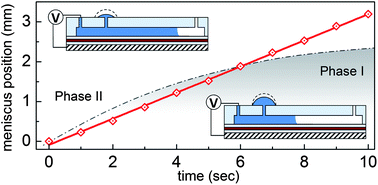A micropump controlled by EWOD: wetting line energy and velocity effects
Abstract
A Laplace pressure gradient between a droplet and a liquid meniscus was utilized to create an on-demand constant flow rate capillary

* Corresponding authors
a
Department of Mechanical, Materials and Aerospace Engineering, University of Central Florida, Orlando, FL 32816-2450, USA
E-mail:
hjcho@ucf.edu
Fax: +1-(407) 823-0208
Tel: +1-(407) 823-5014
b School of Advanced Materials Science and Engineering, Sungkyunkwan University, Suwon, Korea
A Laplace pressure gradient between a droplet and a liquid meniscus was utilized to create an on-demand constant flow rate capillary

 Please wait while we load your content...
Something went wrong. Try again?
Please wait while we load your content...
Something went wrong. Try again?
R. Shabani and H. J. Cho, Lab Chip, 2011, 11, 3401 DOI: 10.1039/C1LC20440H
To request permission to reproduce material from this article, please go to the Copyright Clearance Center request page.
If you are an author contributing to an RSC publication, you do not need to request permission provided correct acknowledgement is given.
If you are the author of this article, you do not need to request permission to reproduce figures and diagrams provided correct acknowledgement is given. If you want to reproduce the whole article in a third-party publication (excluding your thesis/dissertation for which permission is not required) please go to the Copyright Clearance Center request page.
Read more about how to correctly acknowledge RSC content.
 Fetching data from CrossRef.
Fetching data from CrossRef.
This may take some time to load.
Loading related content
